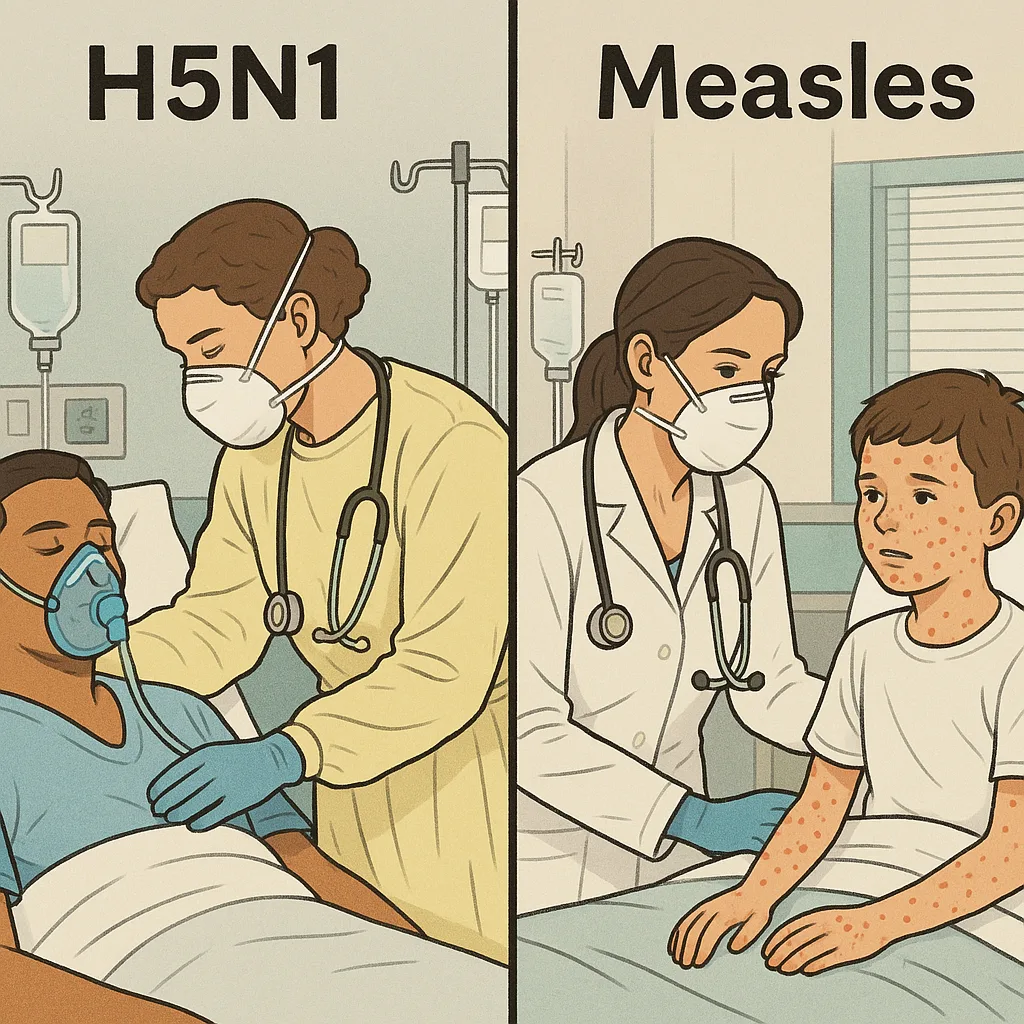Twin Emerging Threats: IPC Measures for Avian Influenza and Measles

In the rapidly evolving landscape of infectious diseases, the infection prevention and control (IPC) challenges are more daunting than ever. According to the Global Preparedness Monitoring Board, “The 21st century brought an undeniable surge in emerging infectious diseases, driven by factors such as climate change, encroachment on animal territories, population growth, and global connectivity. Our reality is no longer one where pandemics are rare shock events but where they pose a constant, real danger.”1 Declines in vaccine uptake in recent years have resulted in the re-emergence of several vaccine-preventable diseases, such as measles, raising concern that these diseases could again become endemic.2 These emerging and re-emerging pathogens can traverse the globe in a mere day, making the task of balancing the day-to-day needs of an already burdened healthcare team increasingly complex. This blog aims to recap the highlights of a presentation that Mariana Torres, MD (BlueDot) and I gave at the Association for Professionals in Infection Prevention and Epidemiology (APIC) annual conference in June of this year. Our talk titled “High-Priority Pathogens: Epidemiology, Potential Spread, and Infection Control Response” highlighted Avian Influenza (“bird flu”) and Measles.

The Epidemiology of the H5N1 and Measles
Highly Pathogenic Avian Influenza A (HPAI) H5N1 is a virus that can cause a respiratory infection with or without conjunctivitis (“pink eye”). Disease severity can range from mild (e.g., upper respiratory symptoms) to severe illness (e.g., pneumonia, multi-organ failure) that may result in death. The H5N1 strain has been the causative agent of the ongoing avian pandemic since 2022. In recent years, the virus has spilled over to other animal species including cattle. Although human cases have been sporadic, in 2024, 70 human cases and one death were reported in the US - most resulting from contact with infected animals. The good news is that there has been no evidence of sustained human-to-human transmission to-date and most cases have been mild. The current risk for the general public is low.3,4
Measles (or Rubeola), a vaccine preventable disease, is an acute viral respiratory illness that presents with a rash. It is one of the most contagious human infections. In fact, nine out of ten exposed individuals will become infected. Measles is spread by direct contact with respiratory secretions as well as by the airborne route. Symptoms include high fever, cough, red watery eyes, runny nose, and a rash all over the body. Vaccine hesitancy has risen since the COVID-19 pandemic. In just the first half of 2025, measles cases in the U.S. hit a record high since it was declared eliminated in 2000.5,6
IPC Measures
Because H5N1 and measles are both spread by the airborne route, they share many of the same IPC measures, with some exceptions.
Screening: Leverage the electronic medical record as travel and infectious disease screening can incorporate with best practice alerts. According to the new Joint Commission standard IC.07.01.01, all patients are to be screened at key points of entry into a healthcare facility for:7
- Fever and cough and/or fever and rash
- International travel in the prior 30 days
- Contact with a suspect or a confirmed case
Isolation and Personal Protective Equipment (PPE): These patients should be masked upon entering the facility and should be promptly roomed in an airborne isolation infection room (AIIR). Healthcare workers should wear a respirator (N95 or higher) to enter the room. To reduce potential exposures, limit the number of people in the room. Aerosol-generating procedures should be limited to medically necessary cases and performed in AIIRs when possible.8,9
- Exception: For H5N1, in addition to airborne precautions, implement contact precautions (gown, gloves, and eye protection).8
Patient transport within the facility should be minimized to only essential purposes, with source control for patients and appropriate PPE for transporters. Identify a low traffic route and be sure to notify the receiving department in advance. Clear other elevator occupants before boarding with the patient.10
Environmental Cleaning and Disinfection: For terminal or discharge cleaning, environmental service professionals should delay room entry until 99.9% of airborne contaminants have been removed (see Table 1).8,11 While these viruses can survive for prolonged periods on environmental surfaces, enveloped viruses are among the easiest to kill through disinfection.3,5 Environmental cleaning and disinfection procedures are per routine but with special attention to frequently touched surfaces.8,12 Linens and waste should be handled per routine and in accordance with Standard Precautions.13,14 See exceptions below.
- Exceptions:
- The Environmental Protection Agency (EPA)’s List Q does not apply to H5N1. Use EPA List M products or those with an H5N1 kill claim.3
- For measles, there is no specific EPA list so use products that have a kill claim for the measles virus.
- Sporicidal disinfectants (e.g., bleach), which have broad-spectrum activity and target harder-to-kill pathogens, are appropriate.15,16
Additional Exception: For H5N1, cultures need to be handled as Category A waste.13,17
| Air Changes per Hour (ACH) | Time required for removal: 99.9% efficiency |
|---|---|
| 6 | 69 min |
| 10 | 41 min |
| 12 | 35 min |
| 15 | 28 min |
Table 1. Adapted from CDC's Guidelines for Environmental Infection Control in Health-Care Facilities. Appendix B1: 2019
Conclusion
In a world where pathogens know no borders, IPC measures are our shield, and vigilance is our responsibility. As we navigate the twin threats of H5N1 avian influenza and measles, our mission is clear: Protect, Prevent and Prepare. Hospitals and other healthcare facilities remain key battlegrounds for these high priority pathogens, which can spread rapidly in these settings. By staying well-versed in IPC control measures, we can mitigate the impact of these immediate threats and safeguard public health. CloroxPro continues to monitor these pathogens, to innovate healthcare disinfectants that rise to the challenge with the right claims and provide up-to-date information as it becomes available. See approved CloroxPro products for use against these pathogens in our Pathogen Education Sheets provided as resources below.
Resources
Share this article
More from the Clorox Pro Blog
References
- Global Preparedness Monitoring Board (GPMB). Annual Global Pandemic Preparedness Report [Internet]. [Cited 2025 Jun]. Available from GPMB.
- Stanford Medicine News Center. Measles may be making a comeback in the U.S., Stanford Medicine-led research finds, Apr 2025 [Internet]. [Cited 2025 Jul 29]. Available from Stanford Medicine News Center.
- CloroxPro. Highly Pathogenic Avian Influenza (HPAI) H5N1 Pathogen Education Sheet [Internet]. [Cited 2025 Jul 23]. Available from CloroxPro.
- Centers for Disease Control & Prevention (CDC). Avian Influenza (Bird Flu): H5 Bird Flu: Current Situation [Internet]. [Cited 2025 Jul 29]. Available from CDC.
- CloroxPro. Measles Pathogen Education Sheet [Internet]. [Cited 2025 Jul 23]. Available from CloroxPro.
- Centers for Disease Control & Prevention (CDC). Measles Cases and Outbreaks [Internet]. [Cited 2025 Jul 29]. Available from CDC.
- The Joint Commission. Standards FAQ: What are the key points to understanding when defining processes that support preparedness for high-consequence infectious diseases or special pathogens? [Internet]. [Cited 2025 Jul 29]. Available from Joint Commission.
- Centers for Disease Control & Prevention (CDC). Interim Guidance for Infection Control Within Healthcare Settings When Caring for Confirmed Cases, Probable Cases, and Cases Under Investigation for Infection with Novel Influenza A Viruses Associated with Severe Disease, Mar 2022 [Internet]. [Cited 2025 Jul 29]. Available from CDC.
- Centers for Disease Control & Prevention (CDC). Infection Control: Guidelines for Isolation Precautions: Appendix A, Feb 2025 [Internet].[Cited 2025 Jul 29]. Available from CDC.
- Centers for Disease Control & Prevention (CDC). 2007 Guideline for Isolation Precautions: Preventing Transmission of Infectious Agents in Healthcare Settings, Updated Sep 2024 [Internet]. [Cited 2025 Jul 29]. Available from CDC.
- Centers for Disease Control & Prevention (CDC). Guidelines for Environmental Infection Control in Health-Care Facilities, Appendix B. Air, 2003, Updated 2019 [Internet]. [Cited 2025 Jul 29]. Available from CDC.
- World Health Organization (WHO). Measles, Nov 2024 [Internet]. [Cited 2025 Jul 29]. Available from WHO.
- Centers for Disease Control & Prevention (CDC). Avian Influenza (Bird Flu): H5N1: Interim Guidance for Infection Control Within Healthcare Settings When Caring for [Cases] with Novel Influenza A Viruses Associated w/Severe Disease, Mar 2022 [Internet]. [Cited 2025 Jul 29]. Available from CDC.
- Centers for Disease Control & Prevention (CDC). Interim IPC Recommendations for Measles in Healthcare Settings, Apr 2024. [Cited 2025 Jul 29]. Available from CDC.
- Centers for Disease Control & Prevention (CDC). Guideline for Disinfection and Sterilization in Healthcare Facilities, 2008 (updated Jun 2024) [Internet]. [Cited 2025 Jul 29]. Available from CDC.
- Centers for Disease Control & Prevention (CDC). A Rational Approach to Disinfection and Sterilization [Internet]. [Cited 2025 Jul 29]. Available from CDC.
- US Department of Transportation (DOT). Planning Guidance for Handling Category A Solid Waste, Apr 2024 [Internet]. [Cited 2025 Jul 29]. Available from phmsa.dot.gov
















